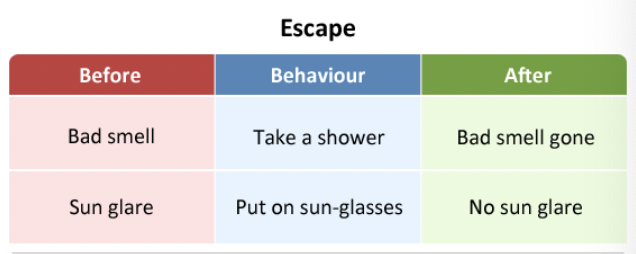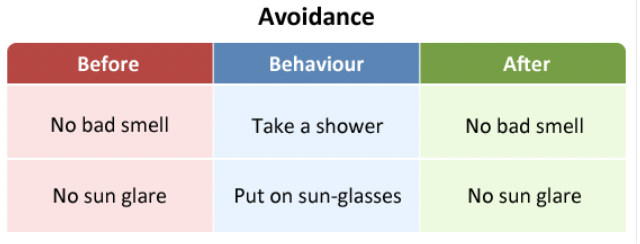Lecture 10: Punishment, Escape, and Avoidance Conditioning
1/22
There's no tags or description
Looks like no tags are added yet.
Name | Mastery | Learn | Test | Matching | Spaced |
|---|
No study sessions yet.
23 Terms
Decreasing Behaviour With Punishment
Define punishment and punisher.
Distinguish between four different types of punishers.
Describe factors influencing the effectiveness of punishment.
Discuss potentially harmful side effects of the application of punishment.
Evaluate the ethics of using punishment as opposed to other methods for decreasing unwanted behavior.
Punisher
Event that when presented immediately after a behaviour, causes that behaviour to decrease in frequency
Synonyms
Aversive stimuli
Aversives
Principle of Punishment
If in a certain situation a person engages in a behaviour that is followed immediately by a punisher, then the person is less likely to do the same thing again in a similar situation.
Behaviour modification view
Punishment is a technical term; application of immediate consequence(s) to decrease behaviour
C occurs immediately after B
Not a moral sanction, vengeance, or retribution
Is not used to deter others from behaviour
Layperson view
Punishment should involve retribution
Should be used as a deterrent for potential wrong-doers
4 types of punishers
Pain inducing
Reprimands
Time outs
Response Cost
Pain inducing punishers (PP)
Physical punishers
Activate pain receptors
Unconditioned punishers
Reprimands (PP)
Verbal reprimands
Fixed stare
Firm grasp
Conditioned punishers
Time outs (NP)
Moving a person to a less reinforcing environment or situation
Exclusionary time-out
Removing person for a short time from situation
Non-exclusionary time-out
Using a stimulus associated with less reinforcement
Exclusionary time out
Removing person for a short time from situation
Non-exclusionary time out
Using a stimulus associated with less reinforcement
Response cost (NP)
Removal of specified amount of reinforcer
May involve indirect effects (delayed punishment)
Should Punishment be used?
Can have harmful effects:
1. Elicits aggressive behaviour
2. Can produce undesirable emotional side effects (i.e., crying, fearfulness)
3. Escape and avoidance behaviour
Can cause the situation and people associated with the aversive stimulus to become conditioned punishers 4. No new behaviour is taught
5. Modeling of punishment
Children may learn to apply aversive stimuli on others
6. Continued use of punishment
Punishment results in quick suppression of undesirable behaviour
This can lead to overuse and not enough use of reinforcement of desirable behaviour
Side effects of Punishment
While punishment can discourage and decrease unwanted behaviours, punishment is the quickest and most effective way of developing fear of failure (Petri & Govern, 2004)
Fear of failure has been shown to decrease performance in competition and overall enjoyment of sport, while increasing the risk for injury and the likelihood of drop out (Smith, Smoll, & Passer, 2002)
Higher levels of fear of failure have also been associated with less academic achievement and with increased use of several maladaptive strategies such as self-handicapping behaviour and school disengagement (Au et al., 2009; Martin, 2012)
Behaviour Modifiers and Punishment Programs
Recommendation: use punishment as a last resort because:
Easy to abuse
Application can have harmful side effects
Consider designing punishment programs only when:
Clear steps are taken to maximize the conditions for a desirable alternative response and to minimize the causes of the response to be punished
It is in the person’s best interest to bring about rapid behaviour change
The intervention meets ethical standards
Punishment is applied according to clear guidelines
Guidelines for Effective Application of Punishment
Select a response –
Punishment is more effective with a specific behaviour
Maximize the conditions for a desirable alternative response
Select alternative behaviour
Provide strong prompts
Reinforce
Minimize the causes of the response to be punished
Select an effective punisher
Present clear SDs
Deliver the punisher
Present immediately after every instance of response to be decreased
Administer in a calm, matter-of-fact manner
Do not pair with reinforcement
Take data
Increasing the Effectiveness of Punishment
Increase stimuli for positive, alternative behaviours
Minimize the cause of undesirable behaviours
Select an appropriate punisher
the more intense the better; however, intensity that is needed is dependent upon causes of undesirable behaviour
Adding an antecedent to punishment SDp stimulus in the presence of which a response will be punished
Delivering the Punisher
Most effective when delivered immediately after the behaviour
Occasional punishment is less effective than punishment that follows every instance of the undesirable behaviour.
Delivery of punishment should not be paired with positive reinforcement – this weakens the punisher
Establishing Behaviour by Escape and Avoidance Conditioning
Define escape conditioning and avoidance conditioning.
Compare and contrast escape conditioning, avoidance conditioning, punishment, and positive reinforcement in terms of the antecedents and consequences involved in each.
Identify and produce examples of escape and avoidance conditioning in everyday life.
Escape Conditioning
Removal of aversive stimuli after response, increases likelihood of response
Negative reinforcement
Aversive stimulus must be present for desired response to occur

Avoidance Conditioning
Behaviour will increase in frequency if it prevents an aversive stimulus from occurring.
Behaviour occurs before aversive stimulus appears
Behaviour increases because it prevents discomfort
No direct exposure to the aversive stimulus

Discriminated Avoidance Conditioning
Involves a warning signal of a forthcoming aversive stimulus
Synonyms: conditioned aversive stimulus, conditioned punisher
A conditioned aversive stimulus is also a conditioned punisher; that is, it will suppress the occurrence of any response that it follows.
Guidelines for the Effective Application of Avoidance Procedures
Avoidance procedure preferable over escape procedure.
Target behaviour should be established by escape conditioning before it is put on an avoidance procedure.
Use warning signal to signal impending aversive stimulus during avoidance conditioning.
Use positive reinforcement in conjunction with escape and avoidance conditioning.
Individuals should be told about the contingencies.
Pitfalls of Escape and Avoidance Conditioning
Undesirable behaviour may be strengthened
Inadvertent establishment of conditioned aversive stimuli
Individual responds by avoiding or escaping them
Maintains undesirable behaviours of the teacher or other caregivers